The Oriental Institute Museum
TREASURES FROM THE ROYAL TOMBS OF UR
By Karen L. Wilson, Museum Director
The Oriental Institute Museum
The University of Chicago
(This article originally appeared in The Oriental Institute News and Notes, No. 167, Fall 2000, and is made available electronically with the permission of the editor.)
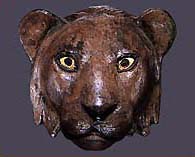 Treasures from the Royal Tombs of Ur, a major traveling exhibition that has drawn record-breaking crowds at each of its previous venues, will open at the Oriental Institute on 21 October. The exhibition features 157 Sumerian objects that were excavated by the British archaeologist Sir Leonard Woolley, director of the joint excavations of the British Museum and the University of Pennsylvania Museum at ancient Ur in the 1920s and 1930s. Items to be displayed include jewelry fashioned from gold, silver, carnelian, and lapis lazuli; elegant vessels made of precious metals, stones, and shell; and a variety of utensils - such as a gold drinking tube, silver and gold cosmetic sets, and weapons - fit for royal use. Most of the items in Treasures from the Royal Tombs of Ur have never been exhibited outside the University of Pennsylvania Museum of Archaeology and Anthropology, which organized the exhibition drawn from the masterpieces that were the museum's share of the division of the finds.
Treasures from the Royal Tombs of Ur, a major traveling exhibition that has drawn record-breaking crowds at each of its previous venues, will open at the Oriental Institute on 21 October. The exhibition features 157 Sumerian objects that were excavated by the British archaeologist Sir Leonard Woolley, director of the joint excavations of the British Museum and the University of Pennsylvania Museum at ancient Ur in the 1920s and 1930s. Items to be displayed include jewelry fashioned from gold, silver, carnelian, and lapis lazuli; elegant vessels made of precious metals, stones, and shell; and a variety of utensils - such as a gold drinking tube, silver and gold cosmetic sets, and weapons - fit for royal use. Most of the items in Treasures from the Royal Tombs of Ur have never been exhibited outside the University of Pennsylvania Museum of Archaeology and Anthropology, which organized the exhibition drawn from the masterpieces that were the museum's share of the division of the finds.
During more than 150 years of archaeological work in what is the modern country of Iraq, probably no excavation has received more public attention than Sir Leonard Woolley's work at ancient Ur in the 1920s and 1930s. (Much of the initial excitement was generated by the fact that the city was the legendary birthplace of the patriarch Abraham (Genesis 11:31), and the fires of public interest soon were fanned by Woolley's discoveries of rich tombs containing evidence of animal and human sacrifice.)
Woolley's first four seasons of work at Ur concentrated on the remains of the temple complex, with its massive and amazingly well-preserved ziggurat, dedicated to the Sumerian moon god Nanna, and to an area just outside that precinct that contained private houses of the early second millennium bc. However, in the middle of the fifth season, while digging in the southeast portion of the sacred enclosure, Woolley encountered burials, uncovering some 600 in less than three months. Over the next several seasons, the expedition excavated intact burials that eventually totaled well over 1,850.
Of the 660 graves that date to the Early Dynastic IIIA period (ca. 2600-2500 bc), the majority were simple inhumations in which a single body, wrapped in reed matting or placed in a coffin, rested at the bottom of a small rectangular pit. In these burials, the deceased was accompanied by a few personal possessions, such as jewelry or weapons, as well as vessels, presumably to hold food and drink.
Sixteen burials, however, were distinguished from the others by their wealth and by the evidence they contained indicating that the deceased had been accompanied to his or her grave by a number of other individuals. Woolley assumed that these interments contained the deceased kings and queens of Early Dynastic Ur and dubbed them "royal tombs." The discovery in the cemetery of cylinder seals whose inscriptions refer to "Meskalamdug, the king," "Akalamdug, king of Ur," and "Puabi, the queen" supported Woolley's suggestion.
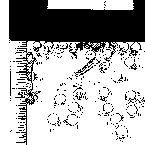 Each royal tomb (see, for example, fig. 1 and fig. 2) had a stone-built chamber with a vaulted or domed ceiling that lay at the bottom of a deep pit, approached from above by a ramp. A body, presumed to be the main burial, lay in the chamber, accompanied by an immense wealth of goods. In some cases, what appear to have been attendants, both male and female, lay in the chamber and/or in the pit adjacent to it, often accompanied by vehicles pulled by oxen or equids. Woolley referred to these pits as "death pits" because of the large numbers of animals and humans contained within.
Each royal tomb (see, for example, fig. 1 and fig. 2) had a stone-built chamber with a vaulted or domed ceiling that lay at the bottom of a deep pit, approached from above by a ramp. A body, presumed to be the main burial, lay in the chamber, accompanied by an immense wealth of goods. In some cases, what appear to have been attendants, both male and female, lay in the chamber and/or in the pit adjacent to it, often accompanied by vehicles pulled by oxen or equids. Woolley referred to these pits as "death pits" because of the large numbers of animals and humans contained within.
Many of the most spectacular items exhibited in Treasures from the Royal Tombs of Ur come from two of these royal tombs: PG 789, which is considered to have been the burial of a king (fig. 1), and PG 800, which was the final resting place of a queen named Puabi (fig. 2). Although it is possible that PG 789 and 800 actually comprise parts of three royal tombs, they are generally treated as two interments, as Woolley saw them.
The chamber of PG 789 had been robbed in antiquity and was nearly empty, containing only two model boats (one made of silver and one of a copper alloy) and an elaborately inlaid gaming board. However, the death pit remained intact. Six soldiers wearing copper helmets and carrying spears "guarded" the pit at the base of the ramp. Within were two wagons, each drawn by three oxen and each fitted with a silver rein ring, one of which appears in the exhibition. Each wagon was accompanied by the bodies of what might have been a groom and two drivers. The bodies of fifty-four other retainers littered the floor of the pit. Some were men who appeared to have been carrying weapons; others were richly adorned women accompanied, in two cases, by elaborate lyres.
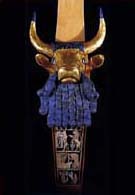 The great lyre from PG 789 is one of the masterpieces of the exhibition (fig. 3 and fig. 4). Most of the lyre was made of plain wood, but the front bore a magnificent bull's head above a series of shell plaques decorated with figures of heroes, animals, and composite creatures. The bull's head (fig. 3) was made of precious materials fashioned over a wooden core. A gold sheet had been used to form most of the head and horns. The curls of hair on the forelock, the tips of the horns, and the magnificent curls of the beard were fashioned of lapis lazuli, which, in the case of the beard, was set in a silver backing. The eyes were made of shell set in lapis with lapis pupils.
The great lyre from PG 789 is one of the masterpieces of the exhibition (fig. 3 and fig. 4). Most of the lyre was made of plain wood, but the front bore a magnificent bull's head above a series of shell plaques decorated with figures of heroes, animals, and composite creatures. The bull's head (fig. 3) was made of precious materials fashioned over a wooden core. A gold sheet had been used to form most of the head and horns. The curls of hair on the forelock, the tips of the horns, and the magnificent curls of the beard were fashioned of lapis lazuli, which, in the case of the beard, was set in a silver backing. The eyes were made of shell set in lapis with lapis pupils.
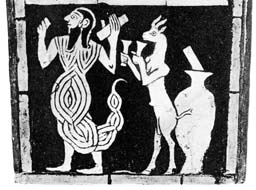 The front of the sound box is trapezoidal in shape and decorated with shell plaques showing lively mythological and animal scenes (fig. 4). The background of each plaque has been cut away and then filled with bitumen, so that the ivory-colored figures stand out against a black background. At the top of the panel is a "master of animals" scene of a type extremely common in Mesopotamian art. In the center a heroic figure, naked except for a braided belt, grasps a rearing human-headed bull in each arm. Some scholars identify this figure as Lahmu ("Hairy"), a protective and beneficent deity who is often associated with bull men. In the next register, a hyena and a lion, both of which assume human postures, bring in provisions for a banquet. The hyena, a knife in his belt, brings in a table laden with animal parts; the lion carries a large jar and a cup or pouring vessel, presumably to hold and serve some liquid refreshment. The cup carried by the lion is identical to vessels of silver and copper alloy from other graves that appear in the exhibition. In the register below, a seated ass plays a lyre with a bull head of the same type as this lyre itself. A standing bear seems to steady the lyre, and a little seated animal rattles a sistrum. In the bottom register, a scorpion man holds undefined objects in his raised hands. Behind him is a gazelle carrying two beakers that are similar to the gold, electrum, and silver tumblers from Puabi's tomb, discussed below, which are also featured in the exhibition. Presumably the tumblers have been filled from the large vessel behind the gazelle. Although representations of a nude bearded hero dominating wild animals and mythical creatures are ubiquitous in the art of Early Dynastic Mesopotamia, representations of animals acting as human beings are not, and the meaning that these scenes would have held for the Sumerians remains a mystery to us.
The front of the sound box is trapezoidal in shape and decorated with shell plaques showing lively mythological and animal scenes (fig. 4). The background of each plaque has been cut away and then filled with bitumen, so that the ivory-colored figures stand out against a black background. At the top of the panel is a "master of animals" scene of a type extremely common in Mesopotamian art. In the center a heroic figure, naked except for a braided belt, grasps a rearing human-headed bull in each arm. Some scholars identify this figure as Lahmu ("Hairy"), a protective and beneficent deity who is often associated with bull men. In the next register, a hyena and a lion, both of which assume human postures, bring in provisions for a banquet. The hyena, a knife in his belt, brings in a table laden with animal parts; the lion carries a large jar and a cup or pouring vessel, presumably to hold and serve some liquid refreshment. The cup carried by the lion is identical to vessels of silver and copper alloy from other graves that appear in the exhibition. In the register below, a seated ass plays a lyre with a bull head of the same type as this lyre itself. A standing bear seems to steady the lyre, and a little seated animal rattles a sistrum. In the bottom register, a scorpion man holds undefined objects in his raised hands. Behind him is a gazelle carrying two beakers that are similar to the gold, electrum, and silver tumblers from Puabi's tomb, discussed below, which are also featured in the exhibition. Presumably the tumblers have been filled from the large vessel behind the gazelle. Although representations of a nude bearded hero dominating wild animals and mythical creatures are ubiquitous in the art of Early Dynastic Mesopotamia, representations of animals acting as human beings are not, and the meaning that these scenes would have held for the Sumerians remains a mystery to us.
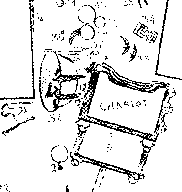 The second royal burial that figures prominently in Treasures from the Royal Tombs of Ur is PG 800 (fig. 2). The chamber of this burial contained the body of a woman, identified by the inscription on a lapis lazuli cylinder seal that lay on her right shoulder as "Puabi, the queen." Woolley judged her to have been just under five feet tall and about 40 years old at the time of her death. She lay on her back on a wooden bier, with female attendants crouched at her head and her feet. The queen wore an elaborate headdress and beaded cape, both of which are featured in the exhibition, as well as other adornments made of precious stones and metals. The chamber held a wealth of other material as well as the bodies of additional attendants, one identifiable as male and one as female.
The second royal burial that figures prominently in Treasures from the Royal Tombs of Ur is PG 800 (fig. 2). The chamber of this burial contained the body of a woman, identified by the inscription on a lapis lazuli cylinder seal that lay on her right shoulder as "Puabi, the queen." Woolley judged her to have been just under five feet tall and about 40 years old at the time of her death. She lay on her back on a wooden bier, with female attendants crouched at her head and her feet. The queen wore an elaborate headdress and beaded cape, both of which are featured in the exhibition, as well as other adornments made of precious stones and metals. The chamber held a wealth of other material as well as the bodies of additional attendants, one identifiable as male and one as female.
Puabi's death pit contained the remains of more than a dozen retainers, most of whom were women. The approach to the pit appeared to have been guarded like that of the king, in this case by five men with copper daggers. The vehicle here was a sled, pulled by two oxen, and accompanied by four grooms. Other attendants within Puabi's pit included ten women, all wearing elaborate headdresses, positioned in two rows "facing" one another and accompanied by musical instruments.
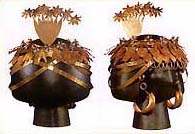 Roughly one-third of the objects in Treasures from the Royal Tombs of Ur come from Puabi's burial. The queen had been adorned with the finest jewelry found in the Royal Cemetery. Her headdress (fig. 5), a less elaborate version of which was worn by her female attendants, was constructed from hundreds of individual pieces fashioned from gold, lapis lazuli, carnelian, and white paste. A gold band was wound several times around the queen's head and over it was placed a frontlet of lapis lazuli and carnelian beads supporting gold ring pendants. This in turn was overlaid by a band of lapis lazuli cylindrical beads and pendant leaves fashioned from sheet gold, each with a carnelian bead at its tip. Another band of pendant leaves, different in form, comprised the next layer. These leaves were separated by gold rosettes with petals inlaid with lapis and white paste. At the back of her head, Puabi wore a gold comb surmounted by rosettes. A pair of large double-lunate earrings were given added support by four spiral twists of gold wire set in locks of hair somewhere close to the ears.
Roughly one-third of the objects in Treasures from the Royal Tombs of Ur come from Puabi's burial. The queen had been adorned with the finest jewelry found in the Royal Cemetery. Her headdress (fig. 5), a less elaborate version of which was worn by her female attendants, was constructed from hundreds of individual pieces fashioned from gold, lapis lazuli, carnelian, and white paste. A gold band was wound several times around the queen's head and over it was placed a frontlet of lapis lazuli and carnelian beads supporting gold ring pendants. This in turn was overlaid by a band of lapis lazuli cylindrical beads and pendant leaves fashioned from sheet gold, each with a carnelian bead at its tip. Another band of pendant leaves, different in form, comprised the next layer. These leaves were separated by gold rosettes with petals inlaid with lapis and white paste. At the back of her head, Puabi wore a gold comb surmounted by rosettes. A pair of large double-lunate earrings were given added support by four spiral twists of gold wire set in locks of hair somewhere close to the ears.
Puabi's burial included numerous vessels of gold, electrum, and silver with elaborate chased decoration as well as an elegant gold drinking straw. Cosmetic containers, some made of precious metal and some of shell, still contained the pigment that would have beautified the queen. Stone vessels occurred in a variety of forms. Dozens of these sumptuous vessels are featured in Treasures from the Royal Tombs of Ur.
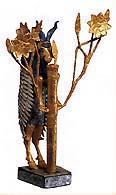 One of the most famous objects from the Royal Cemetery, however, comes not from PG 789 or 800 but from PG 1237 - a burial which Woolley referred to as the "Great Death Pit" because of the large number of retainers (73) buried within. Elaborately fashioned from gold, silver, lapis lazuli, copper, shell, red limestone, and bitumen, this object (fig. 6), and its counterpart in the British Museum, show a goat standing upright with its forelegs resting on the branches of a flowering plant - a common motif in ancient Near Eastern art. Soon after their discovery, these sculptures came to be referred to as “Ram Caught in a Thicket” because they recalled the biblical image of the ram which Abraham found and sacrificed in place of his son Isaac (Genesis 22:13). These figures have become so well known that the Pennsylvania statue is the only ancient Near Eastern work of art illustrated in color in H. W. Janson's History of Art, the standard introductory college art history text.
One of the most famous objects from the Royal Cemetery, however, comes not from PG 789 or 800 but from PG 1237 - a burial which Woolley referred to as the "Great Death Pit" because of the large number of retainers (73) buried within. Elaborately fashioned from gold, silver, lapis lazuli, copper, shell, red limestone, and bitumen, this object (fig. 6), and its counterpart in the British Museum, show a goat standing upright with its forelegs resting on the branches of a flowering plant - a common motif in ancient Near Eastern art. Soon after their discovery, these sculptures came to be referred to as “Ram Caught in a Thicket” because they recalled the biblical image of the ram which Abraham found and sacrificed in place of his son Isaac (Genesis 22:13). These figures have become so well known that the Pennsylvania statue is the only ancient Near Eastern work of art illustrated in color in H. W. Janson's History of Art, the standard introductory college art history text.
Woolley considered the deaths of the retainers and their burial with kings and queens to be an integral element of the royal tombs and vividly described scenes of feasting and music making followed by ritual suicide as the kings and queens of Ur were laid to rest. The media and the public, of course, seized upon the appeal of this mass evidence of human sacrifice. However, scholars have failed to come to any consensus concerning the exact beliefs and practices behind the royal tombs at Ur. Later literary texts such as The Death of Gilgamesh and The Death of Ur-Namma indicate that kings could have underworld palaces and that the burial of a retinue may have been intended to enable royalty to continue living in the style to which they were accustomed, which could be used to explain the multiple burials in the earlier royal tombs at Ur. In addition, two administrative texts - probably lists of grave goods to be buried with high-ranking members of society and dating to within a century of the tombs themselves - include lists of items that are in many ways identical to what was found at Ur, including jewelry, chariots, donkeys, and, in one case, a slave girl. However, as Richard L. Zettler, one of the curators of the exhibition, writes in the exhibition catalog, "No particular explanation of the Royal Cemetery of Ur is completely convincing in our state of ignorance about early Mesopotamian society."
Although the exact belief systems and practices behind the royal burials at Ur are not yet known to us, what is apparent is the high level of technical and artistic sophistication that produced the artifacts that they contain. The array of raw materials from which the objects are made all had to be imported into the resource-poor Mesopotamian floodplain, and their variety attests to the far-flung trading network of which Ur was a part. These materials include gold that must have come from Afghanistan, Iran, Anatolia, Egypt, or Nubia, and etched carnelian beads from the Indus Valley, as well as many stones that perhaps made their way primarily from eastern Iran. With few exceptions, however, these imported materials were worked into final form in southern Mesopotamia by craftsmen who created some of the most spectacular works of art preserved from ancient Sumer.
The exhibition is accompanied by a catalog edited by Richard L. Zettler and Lee Horne, Treasures from the Royal Tombs of Ur (Philadelphia: University of Pennsylvania Museum of Archaeology and Anthropology, 1998) and a special edition of Expedition: The Magazine of the University of Pennsylvania Museum of Archaeology and Anthropology (Volume 40, No. 2, 1998). Both are already available for purchase in the Suq.

